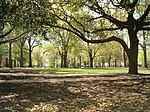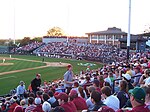Union Station (Columbia, South Carolina)

Union Station (originally Union Depot), also known as Atlantic Coast Line Railroad and Southern Railway Station, is a historic train station located at Columbia, South Carolina. It was built in 1902, and is a brick and stone, eclectic Jacobethan Revival / Tudor Revival building. It features stepped gables and towering chimneys. It was designed by architect Frank Pierce Milburn for the Atlantic Coast Line Railroad and Southern Railway. In contrast to the custom of 'union station' denoting the single station for several railroads, the Seaboard Air Line Railroad had its own station one-half mile away. The formerly Seaboard Silver Star still operates through another station in Columbia.
Excerpt from the Wikipedia article Union Station (Columbia, South Carolina) (License: CC BY-SA 3.0, Authors, Images).Union Station (Columbia, South Carolina)
Calway Alley, Columbia Wales Garden
Geographical coordinates (GPS) Address Website Nearby Places Show on map
Geographical coordinates (GPS)
| Latitude | Longitude |
|---|---|
| N 33.990277777778 ° | E -81.029444444444 ° |
Address
University of South Carolina
Calway Alley
29205 Columbia, Wales Garden
South Carolina, United States
Open on Google Maps








